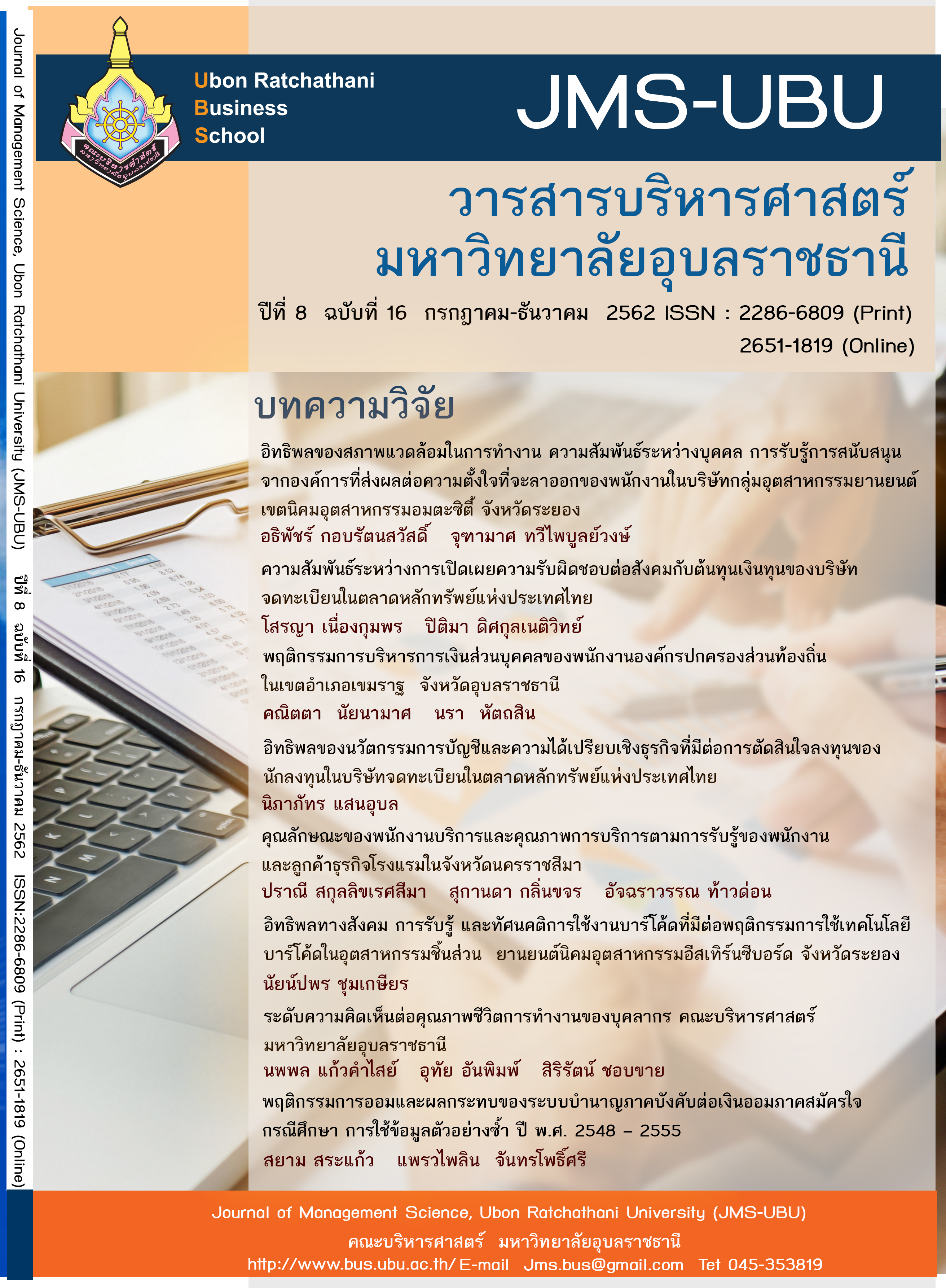คุณลักษณะของพนักงานบริการและคุณภาพการบริการตามการรับรู้ของพนักงานและลูกค้าธุรกิจโรงแรมในจังหวัดนครราชสีมา
Main Article Content
บทคัดย่อ
งานวิจัยนี้ มีวัตถุประสงค์เพื่อศึกษาคุณลักษณะของพนักงานบริการและคุณภาพการบริการตามการรับรู้ของพนักงานและลูกค้าธุรกิจโรงแรมในจังหวัดนครราชสีมา โดยใช้วิธีการวิจัยเชิงปริมาณ ด้วยการเก็บแบบสอบถาม เพื่อเก็บรวบรวมข้อมูลจากผู้ที่เกี่ยวข้องในธุรกิจโรงแรม จำนวน 400 ชุด วิเคราะห์ข้อมูลด้วยสถิติเชิงพรรณนา ได้แก่ ค่าเฉลี่ย ร้อยละ ส่วนเบี่ยงเบนมาตรฐาน และใช้สถิติเชิงอนุมานในทดสอบสมมติฐาน โดยการวิเคราะห์สหสัมพันธ์แบบเพียร์สัน
ผลการวิจัยพบว่า คุณลักษณะของพนักงานบริการโดยรวมในมุมมองของพนักงาน อยู่ในระดับมาก และในมุมมองของลูกค้า อยู่ในระดับมาก โดยที่ มุมมองของพนักงาน พบว่า ด้านจิตใจใฝ่บริการอยู่ในระดับมากที่สุด ซึ่งในมุมมองของลูกค้า พบว่า ด้านความรับผิดชอบอยู่ในระดับมาก อีกทั้ง ระดับคุณภาพการบริการตามการรับรู้ของพนักงานและลูกค้ามีคุณภาพการบริการโดยรวมในมุมมองของพนักงานอยู่ในระดับมากที่สุด และในมุมมองของลูกค้าอยู่ในระดับมาก โดยที่ มุมมองของพนักงาน พบว่า ด้านความน่าเชื่อถือไว้ใจได้อยู่ในระดับมากที่สุด และในมุมมองของลูกค้า พบว่า ด้านรูปธรรมที่ปรากฏอยู่ในระดับมาก นอกจากนี้ยังพบว่าคุณลักษณะของพนักงานบริการ มีความสัมพันธ์ทางบวกกับคุณภาพการบริการ อย่างมีนัยสำคัญทางสถิติที่ระดับ .01 และพิจารณาความสัมพันธ์ของ 2 ตัวแปร ได้ดังนี้ 1) คุณลักษณะของพนักงานบริการและคุณภาพการบริการตามการรับรู้ของพนักงาน มีค่าสัมประสิทธิ์สหสัมพันธ์เท่ากับ .806 จึงยอมรับสมมติฐานที่ 1 ว่า คุณลักษณะของพนักงานบริการมีความสัมพันธ์ทางบวกกับคุณภาพการบริการตามการรับรู้ของพนักงาน และ 2) คุณลักษณะของพนักงานบริการและคุณภาพการบริการตามการรับรู้ของลูกค้ามีค่าสัมประสิทธิ์เท่ากับ .837 จึงยอมรับสมมติฐานที่ 2 ว่า คุณลักษณะของพนักงานบริการมีความสัมพันธ์ทางบวกกับคุณภาพการบริการตามการรับรู้ของลูกค้า
Downloads
Article Details

อนุญาตภายใต้เงื่อนไข Creative Commons Attribution-NonCommercial-NoDerivatives 4.0 International License.
เอกสารอ้างอิง
กัลยา วาณิชย์บัญชา. (2549). การวิเคราะห์ข้อมูลหลายตัวแปร. กรุงเทพฯ : บริษัทธรรมสาร จำกัด.
กรุงเทพธุรกิจ. (2562). บทความพิเศษ เรื่อง “ธุรกิจโรงแรมแข่งขันรุนแรง คาดปี 60 รายได้ขยายตัว 3.7- 5.5%. ค้นเมื่อ 2 มีนาคม 2562 จาก http://www.bangkokbiznews.com/blog/detail/640668
การท่องเที่ยวแห่งประเทศไทย. (2562). จำนวนที่พักและโรงแรม. ค้นเมื่อ 2 มีนาคม 2562 จาก https://www.hotelscombined.co.th/
บุญชม ศรีสะอาด. (2553). การวิจัยเบื้องต้น. กรุงเทพฯ : ชมรมเด็ก.
สายธาร อุทกนิมิต. (2562). ธุรกิจโรงแรมไทย ในยุค AEC . ค้นเมื่อวันที่ 2 กุมภาพันธ์ 2562 จาก https://www.thailandplus.tv/?p=1781.
Brown, A. (1989). Customer Care Management. Oxford: Butterworth-Heinemann. p.89.
Callan RJ, Kyndt G. (2001). Business travelers’ perception of service quality: a prefatory study of two European city centre hotels. Int J Tourism Res. 3(4):313–323.
Chen FY, Chang YH. (2005). Examining airline service quality from a process perspective. J Air Trans Manag. 11:79–87.
Chuang, P.T. (2010). Incorporating disservice analysis to enhance perceived service quality. Industrial Management & Data Systems, 110 (3): pp. 1-21.
Crego, E.T; Schiffrin, P.D., and Albrecht, F.K. (1995). Customer – Centered Reengineering. New York : IRWIN Professional Publishing.
Dedeoglu BB and Demirer H. (2015). Differences in service quality perceptions of stakeholders in the hotel industry. Int J Contemp Hosp Manag, 27(1):130–146.
Gronroos Christian. (1990). Service Management and Marketing: Managing the Moments of truth In Service Competition. Lexington. Massachusetts, pp. 27 – 37.
Heskett, J.L. (1988). “Less ons in the Service Sector. Managing Services : Marketing, Operations and Human Resources. Prentice Hall, p. 374.
K. Douglas Hoffman and John E.G. Bateson. (2002). Essentials of Services Marketing : Concepts, Strategies and Cases. TX : Harcourt College Publishers, pp. 251 – 256.
Kang H, Bradley G. (2002). Measuring the performance of IT services: an assessment of SERVQUAL. Int J Account Inf Syst, 3:151–164.
Kotler, Philip. (2003). Marketing Management. New Jersey : Prentice – Hall International, Inc, 2003.
Lee YC, Chen JK, Lin SB. (2007). Revised Gap analysis by decomposition of service activities: a case study of information system center. Int J Bus Strategy. 8(2):74–98.
Li-hua Fan, Lei Gao, Xin Liu, Shi-hongZhao, Hui-tong Mu, Zhe Li, Lei Shi, King-lling Wang, Xlao-ll Jia, Min Ha and Feng-ge Lou. (2017). Patients’ perceptions of service quality in China: An investigation using the WERVQUAL model. PLoS ONE, 12(12): e0190123.
Mohsan Khudri and Saida Sultana. (2015). Determinants of service quality and impact of service quality and consumer characteristics on channel selection. British Food Journal, 117(8). pp. 2078-2097.
Nakhai, B. and Neves, J.S. (2009). The challenges of six sigma in improving service quality. International Journal of Quality Reliability Management, 26 (7). pp. 663-684.
Nasution H. (2016). Coaligning service quality attributes and its implication to customer value. In: Colin C, Junzhao JM (eds) Looking forward, looking back: drawing on the past to shape the future of marketing. Springer, pp 751–759.
Nunnally, J.C. (1976). Psychometric methods. New York : McGraw-Hill Book Co.
Nykamp Melinda. (2001). The Customer Differential : The Complete Guide to Implementing Customer Relationship Management. AMACOM. New York.
Parasuraman A, Zeithaml VA, Berry LL. (1985). A conceptual model of service quality and its implications for future research. J Mark 49(4):41–50.
Parasuraman, A., Berry, L. L. & Zeithaml, V. A., (1990). Delivering quality service: Balancing customer
perceptions and expectations. New York: The free press.
Tenner, A.R. and DeToro, I.J. (1992). Total Quality Management :Three Steps to Continuous Improvement. Addison-Wesley Publishing, p. 43.
Torres EN, Adler H, Lehto X, Behnke C, Miao L. (2013). One experience and multiple reviews: the case of upscale US hotels. Tour Rev. 68(3):3–20.
Tsang N, Qu H. (2000). Service quality in China’s hotel industry: a perspective from tourists and hotel managers. Int J Contemp Hosp Manag. 12:316–326.
William Joseph. (1983). Professional Service Management. New York : McGraw-Hill Book Company.
Yu-Cheng Lee, Yu-Che Wang, Chih-Hung Chien, Chia-Huei Wu, Shu-Chiung Lu, San-Bing Tsai and Weiei Dong. (2016). Applying revised gap analysis model in measuring hotel service quality, SpringerPlus Journal , (5):1191.
Zeithaml VA, Parasuraman A, Berry LL. (1990). Delivering quality service balancing customer perceptions and expectations. The Free Press, New York.

